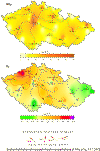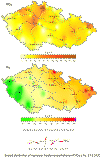|
|
AIR POLLUTION IN THE CZECH REPUBLIC IN 2002 Czech Hydrometeorological Institute - Air Quality Protection Division |
|
|
|
|
2.4 Brief Evaluation of Meteorological Conditions in 2002
Both first winter months of the year 2002 were markedly warmer, January by +1.3 °C and February even by +4.7 °C above the long-term normal. Moreover, in February the record maximum temperatures were exceeded several times in Prague вҖ“ Klementinum where regular measurements have been carried out continuously since 1775. February of the year 1995 had similar temperatures and the warmest February over the recent 25 years was in 1990 with the deviation from normal +4.9 °C. Low precipitation, only 66 % of the long-term normal, occurred in January. Though the January precipitation was only 44 mm on the average, the snow cover in the mountains, thanks to abundant precipitation in November and December 2001 reached from 100 to 240 cm, and at some sites even more. Temperature and precipitation conditions in the winter months by the end of the year 2002 had marked fluctuations. While temperatures in November were higher than the long-term normal (deviation +1.9 °C), the December deviation was -2.0 °C. The monthly total precipitation in November 2002 reached 147 % of the long-term normal. On the contrary, the December precipitation was only slightly above normal. The snow cover formed in late December 2002; the lowlands had up to 8 cm, the mountains about 10 cm and the KrkonoЕЎe Mts. 30вҖ“35 cm. The character of the November weather was prevailingly cyclonal, similarly as in October. In December, on the contrary, the number of anticyclonic situations increased and the relation between the occurrence frequencies of the both types was approximately equal. The above-normal temperatures in November 2002 were caused by the fact that from 11 November to 4 December 2002 there was the leading pressure formation вҖ“ cyclone with the centre above England. On its front side warm air from the south came to central Europe in the given period. Maximum daily temperatures amounted largely above 10 °C and the highest temperature 20.7 °C was measured on 16 November 2002 in LuДҚina (FrГҪdek-MГӯstek). In the beginning of the year 2002 warning signals were issued within the Smog Regulation System (SRS) in the Ostrava region and in Prague. In other monitored areas (northern Bohemia, the foothills of the KruЕЎnГ© hory Mts. and the MДӣlnГӯk region) there were no SRS signals issued. In the Ostrava region the warning signal was issued on 4 January 2002 at 11.20 a. m. On this day formation of a mightier inverse layer above the whole territory of the Czech Republic was observed. For instance, the ground-level midnight temperature in Prague-LibuЕЎ on 4 January 2002 was -14.3 °C, while in the level of 834 hPa the measured value was markedly higher вҖ“ -7.9 °C. The meteorological situation was typical for the formation of unfavourable dispersion conditions. Increased concentrations of nitrogen oxides but also of sulphur dioxide and respirable particles PM10 were measured. This situation lasted all day long on 5 January 2002, only after the passage of the southern edge of the warm front over northern Moravia and Silesia the mighty inverse layer was dissolved, the air mass was exchanged and, consequently, the pollutants’ concentrations decreased. Therefore the warning signal could be cancelled on 6 January at 5.30 a. m. At the beginning of the period, covered by the issued warning signal, the highest nitrogen oxides concentrations slightly exceeded 300 Ојg.m-3 and gradually began to decrease at the end of the first day to the usual level. In Prague the warning signal was issued in mid-January 2002, when the large area of high pressure remained above the central Europe; along its rear side at higher levels warm air entered the country’s territory. This resulted in the formation of temperature inversion, and, consequently, in increasing the values of pollutants’ concentrations in the ambient air, mainly of nitrogen oxides. The alert threshold limit value was exceeded at six stations at 12.00 a. m. on 14 January 2002 and with regard to weather conditions the warning signal was issued at 5 p.m. pursuant to the regulation rules for the city of Prague. The frontal system moved on from the west on 15 January 2002 and after its passage over the territory of the Czech Republic on the following day (16 January) the inversion was dissolved and the values of nitrogen oxides concentrations decreased. The warning signal was cancelled by the municipal authorities of the city of Prague on 16 January 2002 at 9.00 a. m. Maximum half-hour NOx concentration was measured at BranГӯk station вҖ“ 431 Ојg.m-3, while the highest three-hour concentrations did not exceed 294 Ојg.m-3. With regard to the expected improvement of the dispersion conditions the regulation signal was not considered. At the end of the year 2002 no signals within the Smog Regulation System had to be issued in any smog area of the Czech Republic.
The summer of the year 2002 was characterized by significant number of cyclonal
situations which occurred in 64 % of the days between 1 June and 15 September.
As regards temperatures, this period can be generally characterized as slightly
to moderately above normal, as regards precipitation more or less normal, with
the exception of the month of August, which was highly above normal in Bohemia,
and slightly above normal in Moravia and Silesia as concerns precipitation.
Heavy above-normal rainfall resulted in disastrous floods in the Vltava and Labe
river catchments. The amount of sunshine was around normal, with the exception
of the month of August which was slightly subnormal on the major part of the
republic’s territory. In 2002, the ground-level ozone concentrations on the territory of the Czech Republic exceeded the information alert threshold 180 Ојg.m-3 on 5 days in total. At solely one station during one day, this limit value was exceeded on 19 June in PlzeЕҲ (186 Ојg.m-3) and on 20 June in KarvinГЎ (186 Ојg.m-3). On 10 July 5 stations recorded ozone concentrations above the limit value: TuЕЎimice 181 Ојg.m-3, Most 207 Ојg.m-3, Teplice 181 Ојg.m-3, Rudolice v HorГЎch 197 Ојg.m-3 and MartinДӣves 187 Ојg.m-3. On 13 July the limit value was exceeded again at one station only, and namely in Rudolice v HorГЎch (maximum measured value was 199 Ојg.m-3). The last ozone episode of the year 2002 occurred on 23 August with the following concentrations measured at the stations: KarvinГЎ 202 Ојg.m-3, StudГ©nka 188 Ојg.m-3, BГӯlГҪ KЕҷГӯЕҫ 182 Ојg.m-3, RГҪchory 196 Ојg.m-3 and Е erlich 180 Ојg.m-3. The ozone alert threshold value was almost reached also at the beginning and at the end of the summer period: on 17 May 2002 in Hradec KrГЎlovГ© and on 22 August 2002 in KarvinГЎ and BГӯlГҪ KЕҷГӯЕҫ concentrations about 175 Ојg.m-3 were measured. The course of meteorological conditions and ozone episodes occurrences in summer 2002 are shown in Fig. 2.4.1. Synoptic situation during ozone exceedance episodes on 10 July was determined by the cyclone of 1000 hPa with the centre above Scotland and by the anticyclone of 1020 hPa with the centre above the St. Petersburg region. Warm air from the south entered central Europe between these pressure formations. The cold front above western Europe undulated and slowly moved to the east and in late afternoon hours and during the night it passed over Bohemia, followed by cold air mass. The sky over the whole territory of the Czech Republic was clear, in the afternoon cloudy from the west in Bohemia, in the evening and at night there were storms and rain showers. Maximum afternoon temperatures in western Bohemia amounted to 28 °C, the rest of Bohemia had 32вҖ“34 °C, Moravia and Silesia 35 °C. Daily precipitation totals in Bohemia ranged from 2 to10 mm, locally 20вҖ“40 mm.
The highest daily NO2 concentration 115 Ојg.m-3 was recorded at Prague-SmГӯchov
station and the lowest value 4 Ојg.m-3 was measured at BГӯlГҪ KЕҷГӯЕҫ. Concentrations
from 40 to 80 Ојg.m-3 were characteristic for larger cities, in small towns they
ranged about 20 Ојg.m-3. The stations in higher altitudes measured 5вҖ“15 Ојg.m-3 of
nitrogen dioxide. The highest ozone concentration 207 Ојg.m-3 was in Most, the
lowest 105 Ојg.m-3 at the stations in ДҢeskГ© BudДӣjovice and Olomouc. Spatial
distribution of maximum hourly ozone concentrations shows the marked area of the
increased ozone concentrations from Prague to the northwest with maximum value
of 207 Ојg.m-3 in Most. Due to the direction of air flow it can be expected that
ozone contributions to the regional level registered at the stations MartinДӣves,
Most, TuЕЎimice, Teplice and Rudolice result from emission of precursors from the
Prague agglomeration, Kralupy and ZГЎluЕҫГӯ. In the direction from Znojmo to Prague
a belt of concentrations above 150 Ојg.m-3 was observed with the maximum level of
170 Ојg.m-3 in KoЕЎetice. In this case it can be regarded as the northern edge of
„an urban type plume“ coming from Vienna. In previous years airborne
measurements of ozone and its precursors confirmed the existence of such plumes
in Vienna and Prague leeward sides. (Figs. 2.4.2 and
2.4.3) The highest NO2 concentration (193 Ојg.m-3) was measured in Liberec and the levels above 100 Ојg.m-3 were registered also at monitoring stations Ostrava-Fifejdy, Prague-SmГӯchov and вҖ“ which was to a certain extent striking вҖ“ also at the mountainous station Rudolice v HorГЎch where in early morning hours the impact of smoke plume from the power plant had apparent influence. The lowest value of 3 Ојg.m-3 was recorded in ChurГЎЕҲov. Concentrations between 40 and 98 Ојg.m-3 were recorded in larger cities, the range between 20 and 30 Ојg.m-3 was characteristic for small towns, and the values below 12 Ојg.m-3 were reported by the stations situated in higher altitudes. The highest ozone concentration 202 Ојg.m-3 was measured in KarvinГЎ, the lowest value 105 Ојg.m-3 in Sokolov. The spatial distribution of ozone concentrations shows a marked difference between the south-western and north-eastern parts of the Czech Republic. In the Е umava Mts. and in the Bohemian Forest Mts. the concentrations ranged around 110 Ојg.m-3, while in north-eastern Bohemia and Moravia they reached 196вҖ“202 Ојg.m-3. The above mentioned distribution resulted from the fact that beginning from 21 August colder air mass was entering Bohemia behind the cold front, while in the eastern part of the country’s territory the exchange of the original air mass had not occurred yet. (Fig. 2.4.4) Fig. 2.4.1 Course of maximum daily temperatures, their long-term average and daily total precipitation at Prague-LibuЕЎ station, occurrence of ozone concentrations exceeding 180 Ојg.m-3 on the territory of the Czech Republic 1.6.2002вҖ“15.9.2002 Fig. 2.4.2 Spatial distribution of maximum hourly concentrations of NO2 a O3, 10. 7. 2002 Fig. 2.4.3 Distribution of maximum hourly ozone concentrations on the territory of the Czech Republic, 10 July 2002, and three-hour average ozone concentrations in Austria, 10 July 2002 at 16:00 CEST. Fig. 2.4.4 Spatial distribution of maximum hourly concentrations of NO2 a O3, 23. 8.2002
|



